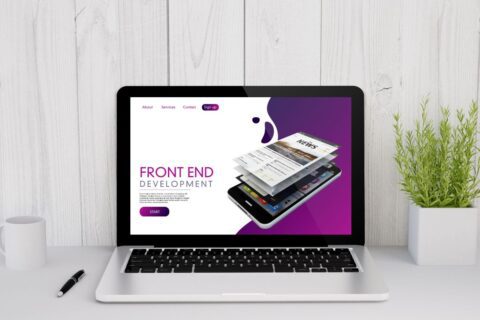Ever visited a SaaS website and felt instantly engaged—like it just got you?
That’s no accident. It’s the result of smart design, subtle motion, and seamless interactivity working together to guide your experience. In a world where users decide in seconds whether to stay or bounce, standing still is no longer an option.
Nowadays in a hyper-competitive digital world, a clean, static webpage just doesn’t cut it—especially for SaaS companies. With rising user expectations, evolving web technologies, and fierce market saturation, SaaS brands are turning to animation and interactivity to elevate their web experiences.
But this isn’t just about visual polish—it’s about crafting intentional, intuitive journeys that lead users to act. Welcome to the era of SaaS Web UX, where animation in SaaS UX and SaaS website interactivity are reshaping how customers engage, decide, and convert.
Why SaaS UX Needs More Than Static Pages?
The landscape of SaaS has evolved rapidly, and so have its users. Modern visitors expect more than just functional pages—they want immersive, dynamic, and personalized experiences.
Growing User Expectations: From onboarding to checkout, users now expect seamless and intelligent digital flows. They’ve experienced advanced interactive SaaS website design from top players and are less tolerant of outdated static layouts.
Saturated SaaS Market: There are over 30,000 SaaS companies globally, with many offering overlapping features. The differentiator? A seamless, engaging SaaS Web UX that builds emotional connection and trust.
What the Data Shows?
According to HubSpot, websites that use interactive elements like animations or calculators see 2X more engagement and 30% lower bounce rates. Another study by Google found that users judge a website’s visual appeal in under 50 milliseconds—making that first impression crucial.
Leading Website Development Agency in Canada
The Role of Animation in SaaS UX:
A. Microinteractions:
These small, subtle animations are everywhere—hover effects, animated loaders, real-time form validation. While easy to overlook, they play a huge role in SaaS website interactivity.
- Examples: Button hover states, toggle animations, in-field validation feedback.
- Why they matter: These website animation effects provide feedback, reduce cognitive load, and guide users smoothly.
How animation improves user experience here is clear—it offers immediate feedback and builds trust, particularly in complex flows like signups or transactions.
B. Visual Storytelling:
Animation also powers the narrative. Think of a homepage hero that subtly animates as the user scrolls, or a product walkthrough that uses motion to demonstrate features.
- Hero section animations draw attention and quickly convey value.
- Explainer videos or guided tours simplify complex products.
- Brand tone comes to life—quirky, sophisticated, or playful—with well-designed motion.
In SaaS, where many features are abstract or technical, animation in SaaS UX bridges the gap between complexity and clarity.
C. Performance Caution:
Too much motion, or poorly optimized motion, can hurt more than help.
- Unoptimized website animation effects CSS can tank your Core Web Vitals scores, leading to slow load times and poor SEO.
- Best practices include lazy loading animations, using SVGs or Lottie files, and leveraging CSS transitions for lightweight effects.
A successful SaaS Web UX must balance beauty with performance.
How Interactivity Drives Engagement and Conversions?
A. Interactive Onboarding:
A great first impression can make or break a SaaS product. Interactive onboarding flows provide real-time, contextual guidance—reducing frustration and drop-off.
- Features: Tooltips, progress indicators, guided product tours.
- Impact: Up to 50% reduction in user churn during the first 7 days (according to Appcues data).
This approach not only personalizes the experience but ensures new users quickly find value—one of the top SaaS UX trends 2025.
B. Interactive Pricing Pages & Calculators:
Static pricing pages are outdated. Users now expect clarity, flexibility, and instant insights.
- Interactive features: Sliders to adjust user seats, ROI calculators, dynamic cost estimates.
- Benefit: Higher dwell time, more informed decision-making, and fewer objections during sales.
This kind of SaaS website interactivity builds user confidence and aligns expectations.
C. Real-Time Demos and Live Previews:
Letting users try before they buy is a game-changer.
- Live sandboxes, embedded product previews, and click-through demos help demonstrate value upfront.
- These interactive SaaS website designs provide instant gratification—a major SaaS UX trend for 2025.
When done right, they lower friction and boost sign-ups by up to 40%, according to SaaS CRO experts.
Best Practices in Web Design for SaaS Companies in 2025
Design Tips for SaaS Teams:
1. Guide, Don’t Distract:
Animations should support user tasks—not pull focus. Use motion to direct attention subtly, not for entertainment.
2. A/B Test Motion:
Use tools like Hotjar or Google Optimize to test how animation impacts conversion. Sometimes, removing a fancy effect increases speed and leads to more sign-ups.
3. Use the Right Tools:
For modern website animation effects CSS and interactivity:
- Lottie for lightweight animations
- GSAP for timeline-based animations
- Framer Motion for React-based apps
4. Prioritize Accessibility:
Always include a “prefers-reduced-motion” CSS query. Some users (especially neurodivergent ones) may find motion disorienting. Accessibility is no longer optional—it’s part of good UX.
Real Examples of SaaS Brands Doing It Right:
1. Notion:
- Uses fluid animations during onboarding and editing.
- Seamless SaaS Web UX that makes even complex features feel intuitive.
2. Webflow:
- Rich interactive SaaS website design with real-time design previews.
- Combines website animation effects CSS with high performance.
3. Slack:
- Clever microinteractions and delightful motion in their onboarding.
- Brings personality and clarity to every part of the experience.
These brands understand that how animation improves user experience isn’t just about looks—it’s about user control, flow, and confidence.
Conclusion:
In 2025, SaaS UX trends are all about connection, clarity, and control. Users want digital experiences that feel human—and that’s where animation and interactivity shine. Whether it’s a subtle hover effect, a personalized product tour, or a real-time ROI calculator, these design elements are no longer “nice to have”—they’re essential.
So if your SaaS website still feels like a brochure from 2015, it’s time to rethink your strategy.
Animation in SaaS UX, when used with intent and optimized correctly, leads to better engagement, lower churn, and stronger conversions. And in a saturated market, that’s what sets the best apart.
FAQs
How does animation improve user experience on SaaS websites?
It provides feedback, enhances navigation, reduces confusion, and makes interactions feel more intuitive—especially during onboarding or multi-step flows.
What types of animation are most effective in SaaS UX?
Microinteractions (hover states, form validation), onboarding walkthroughs, and motion in product demos or hero sections are highly effective.
Are interactive SaaS websites harder to build?
They can be more complex, but modern tools like Framer Motion, GSAP, and Lottie make it easier than ever to create rich interactive experiences without sacrificing speed.
How do you optimize website animation effects CSS for performance?
Use lightweight animations (CSS over JS where possible), leverage hardware-accelerated properties (transform, opacity), and always optimize for reduced motion settings.







